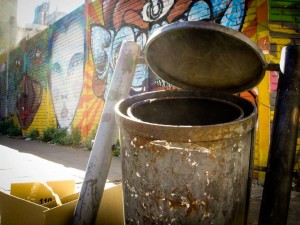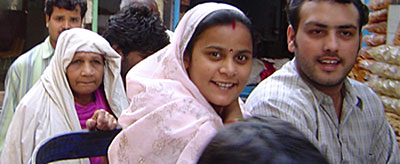On Saturday I went on a photography tour that is a great way to experience Buenos Aires, and I strongly recommend that everyone place Fota Ruta high on a list of things to do in Buenos Aires. I put tour in italics since this turned out not to be a guided tour at all. Plus, it’s not just for photographers.
Every Saturday afternoon Foto Ruta has a gathering that explores a different neighborhood of Buenos Aires. This past weekend focused on San Telmo. The meeting location was a small restaurant on Balcarce. When I first got the email indicating the starting point I knew this was going to be slightly different from other encounters with touristic operations. Balcarce is one of my favorite streets in San Telmo but absent the large crowds that stream down Defensa. A few people were mingling in front of the resto when I arrived and a couple more soon joined. I was expecting Joss, one of the people who runs Foto Ruta, to appear, chat with us a for few minutes, and then lead us down the street. After all, that’s the typical walking tour routine.
Instead, we went into the restaurant where Foto Ruta staged a much bigger production than I imagined. On a table were nicely spread out several photography books for us to browse and an abundance of handouts, even including a lanyard (which doubled as a camera strap). I had to inquire who was their graphic designer since all the Foto Ruta publications were extremely well designed as is their website. Turns out the credit goes to Joss, who has a background in graphic design and photography. Her photographic understanding became even more evident as the afternoon went by.
The first forty-five minutes of the tour is spent sitting in the restaurant, which offered a good opportunity to get to know the others who have come on the tour that day. In my group were a guy from Iceland living in Sweden, two young women from the UK, and two other expats residing in Buenos Aires. Joss presented an overview of Foto Ruta, explained the concept of the tour, a brief history of the barrio, and then proceeded with a wonderfully illustrated presentation (on a large screen) about ways to compose better photographs that was filled with really useful advice and examples.
The innovative approach of Foto Ruta is that it’s not a guided tour showing you a dozen picture perfect spots for taking those quintessential photos of Buenos Aires. Rather, Foto Ruta is about helping you see beyond the touristic surface of a barrio and along the way you find the wonderful images that resonate with you. On a Foto Ruta excursion you go off on your own or with a small group if you so choose, then meet back at the restaurant in a couple of hours to review a selection of photos that everyone took that afternoon. To aid that process of discovery Foto Ruta provides a map, a list of useful phrases in Spanish, and, most importantly, a set of ten clues to stimulate your visual thinking. These clues are not the mundane “Find the old bar at the corner of Plaza Dorrego”, but a brief phase: Dorrego Daydreams. The interpretation is yours. And isn’t that the key to a great travel experience? We’re each internalizing our own encounters with a place. And photography can help express that in imagery.
On Saturday I teamed up with Oli, the Icelander residing in Stockholm. That’s also the great benefit of Foto Ruta: a chance to make new friends. Over a couple of hours of wandering a neighborhood you have a lot of time to talk, maybe sit down in a cafe for a coffee. Oli turned out to have a fantastic eye for photography (not surprising that he carried two film cameras and one digital). Here’s a photo Oli took for the clue “A pigeon’s picada”.

Even though I know San Telmo incredibly well, having lived in that barrio from 2005 – 2008, I still encountered new sights. And the neighborhood has changed in the last few years but much has remained the same. We wandered in a bookstore filled with old books. No other customers in the store but in the back was an old man with long white hair. After glancing at him I had to turn and look again at the object in his lap. He was making shoes. After a conversation it turned out that he’s a custom shoemaker who will measure your feet and craft a pair of shoes by hand. Stumbling across that type of encounter makes for a memorable afternoon.

Oli and I returned to the restaurant where Joss and her Finnish assistant Sari had bottles of wine waiting. The others soon arrived and everyone selected a photo that best matched each of the ten clues. Even if you’re not so into photography this made for a wonderful Saturday afternoon. You don’t even have to take photos; you can team up with another. And there’s no wrong answers when seeking out photos for the clues. You can be quite abstract and conceptual, plus most clues are quite broad and open to interpretation. As we’re sitting around drinking wine and chatting Sari copies the photos from everyone’s digital cameras and then Joss turns on the large screen monitor so that we can see the photos. Joss provides an excellent but gentle critique of the photos. This is not a graded exercise and she deftly finds something good to say about every photo. Indeed, some of the photos are quite remarkable. Check out the gallery page on Fota Ruta.
Seriously, if you’re into photography and you’re in Buenos Aires or visting the city then you’re going to enjoy the Foto Ruta experience. In addition to the Saturday excursions Foto Ruta also offers half-day and full-day workshops on street photography, a half-day on iPhoneography, plus a full-day post production workshop. That’s an exciting set of opportunities for anyone interested in photography.
I love Fota Ruta’s concept for getting people to truly experience the streets of Buenos Aires. You won’t learn anything about the history of a 19th century military leader and politician named Manuel Dorrego, but you’ll surely come away with lasting memories and new insights in photography.










